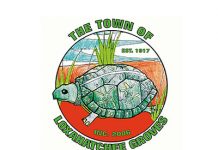
Being brought to the Loggerhead Marinelife Center earlier this month was pivotal for Pennywise, a huge, 302-pound adult loggerhead turtle with significant (and partially healed) blunt force trauma to her shell — likely from a boat strike about a month prior.
“She was found up in the St. Lucie area by Inwater Research Group. They brought her to us,” said veterinarian Dr. Heather Barron, chief science officer at the facility.
Turtles usually take about a week or so to adjust to being fed in captivity, Barron said, and Pennywise is slowly adjusting to her new diet. But for now, it has been about testing and wound care. Her wounds weren’t fresh — they were already starting to heal when she arrived.
“She is in pretty good shape, all things considered,” Barron said. “She had already done a lot herself to try and get that wound healed. We are just really cleaning up for her.”
However, when they tried to see what was going on inside of her, the equipment at Loggerhead wasn’t big enough. So, they took her to Jupiter Medical Center, and she was still too big. That is when she made a trip to Wellington, to use the large-animal equipment available at the Palm Beach Equine Clinic.
“We haven’t done any exotic animals or marine life before this, but we have been open, offering our services to Lion Country Safari if they had any animals in need,” said Dr. Karen Beste of Palm Beach Equine Clinic. “We’re really lucky to have this CT [scanner]. It’s extremely versatile. It’s a very powerful machine, and it’s obviously big enough to get some animals that wouldn’t normally have imaging options. We’re really happy to be able to help this turtle. Anything we can do to help any animal in need, if that’s some service that we can provide, then that’s going to be something we really look forward to doing.”

The CT scan showed there was some damage involving Pennywise’s spinal column, and that there was an infection that was eating away at the bone.
“But the good news is that her spinal cord seems to be functioning normally,” Barron said.
Loggerheads like Pennywise don’t typically start nesting until they’re 25 to 35 years old, and Pennywise was first documented nesting in 2018. She received flipper tags for identification and was seen nesting by the Loggerhead team. She is one of the many sea turtles that uses the beach behind Loggerhead as a nesting ground.
“We’re so lucky to have so many healthy sea turtles nesting on our beaches here. Last year it was about 16,000. The year before that, it was 25,000,” Barron said. “There’s roughly another sea turtle nest about every two feet on the beach behind our center.”
Nesting has been going on for the last month or so for loggerheads, she added, and if they can get Pennywise recovered quickly, she can go out and lay her 100-plus eggs, as shown in the CT scan. Most loggerheads lay between 70 and 100 eggs, but only one in 100 is likely to make it through the juvenile age, and one in 1,000 is likely to make it to the age of nesting and breeding.
So, Pennywise theoretically would have to lay 1,000 eggs to have one offspring potentially survive to breeding age.
To help protect sea turtles and other marine life, Loggerhead has enacted a voluntary zone from the shore to one mile offshore that encompasses all of Palm Beach County from March 1 to Oct. 31 called the Sea Turtle Protection Zone, where endangered and threatened turtles are most likely to be engaging in reproductive activity and not noticing when a boat is coming. Boaters are asked to travel at a reduced speed within this zone, and to travel outside the zone when possible. They also suggest wearing polarized sunglasses and designating a spotter to watch out for wildlife. Learn more at www.marinelife.org/conservation/sea-turtle-protection-zone.
Her advice to non-boaters? Be careful, respectful and be sure not to touch the turtles or their nests.
At Loggerhead, they’ve already seen about 130 juvenile to adult sea turtles this year; typically, they see 200 a year, as well as thousands of hatchlings or washbacks, which are post hatchlings that have made it out into the water but then washed back for some reason. For their more mature sea turtles, the first 24 hours are critical, and after that, their survival rate is 80 percent.
“We have some very long hours here, but I’m lucky to have an amazing, dedicated team,” Barron said. “We’re lucky to have some really excellent partners in these endeavors.”
Now, they get to include Wellington’s Palm Beach Equine Clinic on the list.
“A big thanks to Dr. Karen Beste, who allowed us to come in and use their machine and help us with getting good CT scan images, because those were really important for us to be able to get a good diagnosis and treatment plan for Pennywise,” Barron said.
If you see a sea turtle that is injured, deceased, harassed or see someone disturbing a turtle nest, contact the Florida Fish & Wildlife Conservation Commission at (888) 404-FWCC (3922) or dial *FWC or #FWC on your cell phone.
Loggerhead does have a container in front of the center for people to drop off hatchlings that are injured or disoriented from the beach. The Juno Beach facility is free to visit and hosted more than 300,000 visitors in 2024. It’s kid-friendly, and something that can be explored in about four hours. For more information, visit www.marinelife.org.







